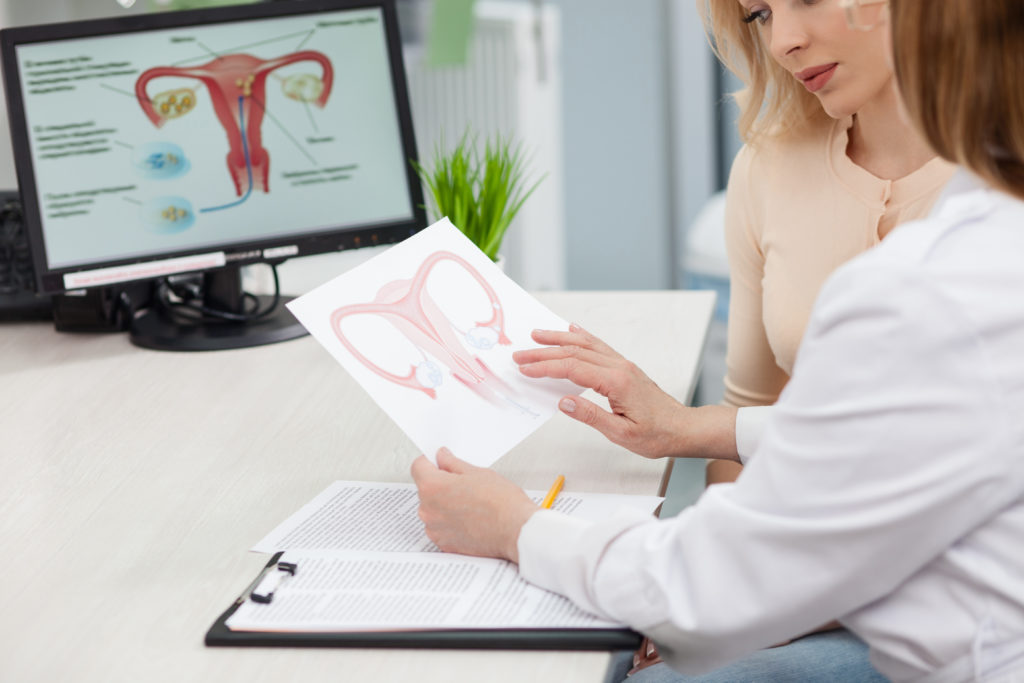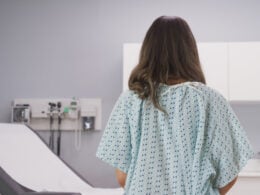If you’re having trouble with irregular periods and other reproductive or menstrual issues, you’re not alone.
Your symptoms may include cramps, irregular and/or painful periods, recurring ovarian cysts, depression or mood problems, infertility, and more.
Generally, most medical providers prescribe hormonal birth control in response to these period problems. These drugs may help with symptoms, but they do not treat the root cause(s). They can also cause side effects and sometimes serious health risks for their users.
In this free guide, we’re going to share about:
- Treatments and doctors that deal with root causes based on your personal hormonal profile,
- How to prepare a thorough report of your condition with our exclusive symptom checklist,
- Unique insights about six common reproductive health conditions.

Treatments and doctors that can really help
Evidence-based methods to diagnose and actually treat irregular periods or other menstrual issues exist but many medical providers aren’t aware of them.
Fertility Awareness Methods (FAMs) approach identifies problems with a woman’s cycle by examining her fertility tracking charts and other diagnostic tests and technologies, and then using this information to prescribe a precise, individualized treatment for her menstrual or reproductive issues.
Doctors who know how to use FAM charts to assist their patients in diagnosis and treatment of menstrual issues are trained in Restorative Reproductive Medicine (RRM).
These healthcare professionals have chosen to supplement their medical degree(s) with training in RRM. In growing numbers throughout the US, most of them are either OB/GYN, Family Medicine doctors, nurse practitioners, or other specialties. Find a list of providers here.
Recording all your symptoms with a checklist
It is not always easy to recognize and report all the symptoms of menstrual issues, and that’s why we designed a practical Cycle Symptom Checklist that will guide you in the process.
This is an example of what a health professional trained in RRM would ask you and shows how thorough they are. You can simply fill it out and get a PDF with your own results by filling out this confidential checklist of your symptoms.
With these results in hand, have a conversation with your healthcare provider, or check out RRM providers here.
Key facts about six common reproductive health conditions
Below, we highlight six common reproductive health conditions, what they are, what can cause them and how a Restorative Reproductive Medicine provider can help.
Irregular periods
What does it mean to have irregular periods or irregular cycles? A woman has irregular cycles when she experiences one of the following consistently: a) her period is shorter than 21 days or longer than 36 days; or b) her period varies by 5 or more days (e.g., one cycle is 22 days long, then the next is 40 days long, and the next is 34 days long, and so on.)
Irregular periods can be normal at certain points in a woman’s fertility, especially during the transitional phases of fertility, e.g., the onset of puberty, during breastfeeding, and during perimenopause. But if a woman is not in a transitional stage of fertility, and consistently experiences irregular periods, they could signify an underlying reproductive disorder.
While young women are often prescribed hormonal birth control to “regulate” their periods, hormonal contraceptives do not actually regulate periods: birth control instead uses synthetic hormones to override a woman’s cycle, keeping her from ovulating and menstruating. The monthly bleeding experienced by a woman on birth control is not actually a period, but a withdrawal bleed.
Contrary to popular belief, it is possible to chart your menstrual cycle, even if you have irregular periods! In fact, charting your cycle with a fertility awareness method (FAM) can help you and an RRM-trained doctor get to the root of your irregular period symptoms, without using birth control.
For more information and resources on irregular periods, click here.
WATCH: How to solve irregular periods without birth control with Dr. Monique Ruberu, OB/GYN (3 minutes). Click here to watch it in Youtube.
Ovarian cysts and Polycystic Ovary Syndrome (PCOS)
Some cyclic, one-sided pelvic and lower abdominal pain can be attributed to mittelschmerz, otherwise known as ovulation pain. But chronic pelvic pain on one or both side of your lower abdomen and pelvis can indicate ovarian cysts.
Some types of ovarian cysts are more serious than others. Knowing the type of ovarian cysts you have and the cause of those cysts is an important part of getting the right treatment.
A physician trained in Restorative Reproductive Medicine can use your fertility cycle charts and other diagnostic tests (such as blood tests and ultrasounds) to determine whether you have polycystic ovary syndrome (PCOS). With this information, they can prescribe lifestyle changes and treatments (such as supplementation with bioidentical hormones) that may help treat the root cause of your PCOS symptoms. In some cases, surgical treatment for ovarian cysts may be necessary.
For more information and resources on ovarian cysts and PCOS, click here.

Endometriosis
Endometriosis is a disorder in which tissue similar to that which lines the uterus (called the endometrium) grows outside of the uterus. The most common symptom of endometriosis is pain. This pain typically occurs in the lower abdominal area and lower back, but it can also occur in the hips and legs, or even (rarely) the chest.
Endometriosis is not well understood, and for a variety of reasons (including lack of patient and provider awareness, dismissal of women’s pain, and misdiagnosis) can take an average of eight years to diagnose from the onset of symptoms.
Learning to chart your cycle with the help of a trained Fertility Awareness Method instructor and/or a medical provider familiar with your Fertility Awareness Method can help you detect signs of endometriosis. Doctors trained in Restorative Reproductive Medicine have pioneered various surgical techniques for the treatment of endometriosis that aim to manage the disease itself (rather than just its symptoms). Treatment may involve laparoscopic surgery to excise the lesions caused by endometriosis, as well as diet, exercise, and nutritional supplementation.
For more information and resources on endometriosis, click here.
WATCH: Treating endometriosis for real with Dr. Monique Ruberu, OB/GYN (1.4 minutes). Click here to watch it in Youtube.
Premenstrual Syndrome (PMS) / Premenstrual Dysphoric Disorder (PMDD) / Depression
PMS
If you’re a woman of reproductive age, chances are that at some point you’ve experienced an uncomfortable combination of symptoms warning you about your period’s arrival—symptoms like headaches, mood swings, irritability, or bloating before your period, and more. There isn’t a unified consensus about what exactly causes this phenomenon, often referred to as premenstrual syndrome (PMS) [1]. PMS symptoms can be a normal sign of the hormonal shifts that naturally occur during a woman’s cycle.
Some girls and women may be more sensitive to these natural hormonal fluctuations than others. They may experience more severe symptoms of PMS, which may cause them to miss school or work. Some researchers theorize that a hormonal imbalance (namely low progesterone) may be at play with more severe PMS symptoms. Various dietary and lifestyle choices may also contribute to certain PMS symptoms, including overconsumption of sugar, lack of sleep, and stress. Doctors trained in Restorative Reproductive Medicine can assist women in treating PMS without requiring them to take synthetic hormones or birth control.

PMDD
Premenstrual Dysphoric Disorder or PMDD is a debilitating health condition. A woman with PMDD experiences extreme depression, irritability, anxiety, or anger in the two weeks leading up to her period. PMDD is far more severe than the moodiness and general irritability that many women often experience as part of PMS. Women with PMDD cannot function in everyday life, and may be at risk of harming themselves or others.
Researchers are uncertain as to why PMDD occurs in some women but not others. There are a few theories that may explain why PMS escalates to PMDD, ranging from a progesterone deficiency, to diminished serotonin activity triggered by the ovulatory cycle. Doctors trained in Restorative Reproductive Medicine can help women suffering with PMDD to find effective treatments to restore their hormonal balance.
Depression
Some women may mistake PMS moodiness or the extreme mood swings of PMDD for an underlying, generalized depression or anxiety disorder, conditions which often worsen in the days leading up to one’s period. If your anxious or depressive symptoms do not completely resolve when your period begins, you may actually have a depression or anxiety disorder. It is important because the type of treatment should be very different if it’s one versus the other. As a result, a woman may be prescribed a psychotropic medication when a bio-identical hormonal supplement would be more effective.
Charting your cycle can help you keep better track of when your anxious or depressive symptoms begin and end, and how they correlate with changes in your cycle.
While doctors are often quick to prescribe birth control to combat PMS and PMDD, there is a significant link between birth control use and depression, especially among young women. Thankfully, doctors trained in Restorative Reproductive Medicine techniques have the ability to treat PMS and PMDD without the use of the synthetic hormones found in birth control, which may make depression worse.
For more information and resources on PMS, PMDD, and depression, click here.
For more information and resources on birth control and depression, click here.

Postpartum Depression (PPD)
Women may be especially at risk for developing depression after giving birth.
Like general depression, postpartum depression (PPD) is a serious mental health issue requiring medical attention. While approximately 85% of women may experience “the baby blues” after giving birth, the feelings of sadness and anxiety associated with the baby blues typically last only for a few days postpartum. The symptoms of PPD are more severe and last for two or more weeks.
While some women may require antidepressant medication and/or psychotherapy to treat their PPD, doctors trained in restorative reproductive medicine may be able to treat PPD with bio-identical hormone therapy.
For more information and resources in postpartum depression, click here.
WATCH: Post-Partum Depression can be treated hormonally with Dr. Monique Ruberu, OB/GYN (2.2 minutes). Click here to watch it in Youtube.
Hormone imbalance
Hormone imbalances manifest themselves through a variety of symptoms including painful, heavy periods, pelvic or lower abdominal cramps, cystic acne, low sex drive, moodiness, and more. Hormonal imbalances can also make it difficult to conceive a baby and carry a pregnancy to term.
It’s important to learn about illnesses that can cause hormonal imbalances so you can pursue effective treatments, instead of simply covering up the symptoms with hormonal birth control. Doctors trained in Restorative Reproductive Medicine can assist patients with hormonal imbalances by restoring their natural hormone levels with tailored treatments of bioidentical hormones to support the natural cycle, as opposed to synthetic hormones (such as those found in hormonal contraceptives) that override the natural cycle.
For more information and resources on hormonal imbalances, click here.
If you believe you could be suffering from one or more of the reproductive or menstrual disorders described above, know that help is available.
Learning to chart your cycles with a Fertility Awareness Method can be a great first step towards helping your doctor identify the root causes of your reproductive or menstrual disorder, so that you can get authentic treatment, tailored to your unique needs.
To find a doctor trained in Restorative Reproductive Medicine click here.
To fill out our exclusive Cycle Symptoms Checklist click here.
This article was updated on March 12th, 2024.











